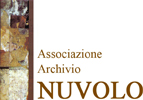Biography
Giorgio Ascani (Città di Castello, 1926-2008) received the nickname Nuvolo during the Resistance, for his ability to appear and disappear in silence among the Umbrian hills, just as clouds do on mild spring days.
“When I went to Rome to see Burri – Burri who was from Città di Castello and heard me called Nuvolo – he introduced me to his friends as Nuvolo. At that point when I did my first exhibition, I had no choice but to sign it Nuvolo, otherwise no one would have recognised the author”.

It was his father who introduced Giorgio to art when, at the age of seven, he asked him to paint the scenery for a small theatre set up in their home in Via del Calcinaro, in the district of San Giacomo.
At the age of thirteen, he enrolled in the Scuola di Avviamento Professionale (vocational training school) but did not complete the course.

In 1944, shortly before he came of age, he enlisted as a partisan and was given the name Nuvolo. Once the war was over, Giorgio returned to his old job, but with the station bombed out and the warehouses half-empty, he soon became unemployed; it was during this period (1949) that Nuvolo first met Burri, an already established artist in Rome, during one of his solo exhibitions at the Galleria dell'Angelo.

In 1955, a few months apart, he was the protagonist of two personal exhibitions, the first at Galleria Le Carrozze in Rome curated by Villa, the second at Galleria Numero in Florence presented by Cagli.

In 1957, he participated in the group exhibition “Trends in Watercolour Today, Italy - United States” at the Brooklyn Museum in New York, and the following year he exhibited at Gallery One in London in “5 Painters from Rome”. In 1959 he was invited to the itinerant exhibition “Contemporary Italian Drawing and Collage” shown in nine cities in the USA; in this year Nuvolo won the “Sorelle Fontana Painting Prize” competition. In October 1959, his eldest son Piergiorgio was born.

In 1961, relations with Plinio de Martiis and La Tartaruga began to break down; Topazia Alliata remained - for a few more years - Nuvolo's reference gallerist. In this same year, Nuvolo showed his first interest in teaching and proposed a treatise entitled Serigrafia in schools to the Ministry of Education, to explain why it was essential to include this new discipline in the graphic arts and printing institutes.
In October, his second son Paolo was born. In 1962 he exhibited for the first time in a solo show in Germany, at Gallerie Senatore in Stuttgart; the following year he returned to America for “8 Contemporary Artists from Rome” at the Minneapolis Institute of Art.

By this time, relations with galleries had ceased, and Nuvolo continued his work with the Atelier of serigraphy and the reproduction of graphic works for Ettore Colla. In these years he began to collaborate with some publishers as head of graphics for art catalogues, for Accademia Editrice he worked on, among others, I cancelli delle fosse ardeatine of Mirko (1968), La Crocifissione of Renato Guttuso (1970) and La Battaglia di San Martino of Corrado Cagli (1971). With Studio Nuvolo he also designed and produced many brochures and leaflets for solo exhibitions of other artists, as well as the silkscreen covers for the quarterly magazine “Carte Segrete”.
The first limited edition works signed by Corrado Cagli and reproduced by Nuvolo in his silkscreen printing atelier in Via Lungotevere Artigiani, 10 in Rome date back to 1967.
In 1969, he won his first professorship at the Vasto Art Institute, before moving first to Foggia and then to Rome.

By the mid-1970s, Nuvolo had already reproduced limited edition works by: Cagli, Caruso, Conte, Guttuso, Mastroianni, Meo, Napoleone, Rotella and Turcato.
Another important solo exhibition “Nuvolo. Presentazione ciclica delle opere” curated by Corà at Studio Piattelli in Piazza del Gesù in Rome; the following year he won the Chair of Painting at the Pietro Vannucci Academy of Fine Arts in Perugia, of which he became Director a few years later, a post from which he took leave in 1984.
In 1984, Nuvolo left Rome for good to move with his family to Città di Castello, where he also moved his silkscreen printing atelier.

In 1993, the anthological exhibition “Nuvolo la pittura e l’atelier di serigrafia”, curated by Bruno Corà, was held at Rocca Paolina and Palazzo Penna in Perugia and at Palazzo Vitelli in Sant'Egidio in Città di Castello, displaying all the work Nuvolo did on his own and for third parties in forty years of activity.
Between the second half of the 1990s and the early 2000s he took part in group exhibitions curated mainly by Maurizio Calvesi, Bruno Corà, Aldo Iori and Aldo Tagliaferri.
In December 2005, he inaugurated his solo exhibition at the Pinacoteca di Città di Castello, “Nuvolo lo spazio pittorico tra caos e ordine”, curated by Bruno Corà, which presented the artist's entire oeuvre, from the “Serotipie” of 1951 to the “Legni Collages” of 2002.
Nuvolo leaves us on 10 October 2008.


